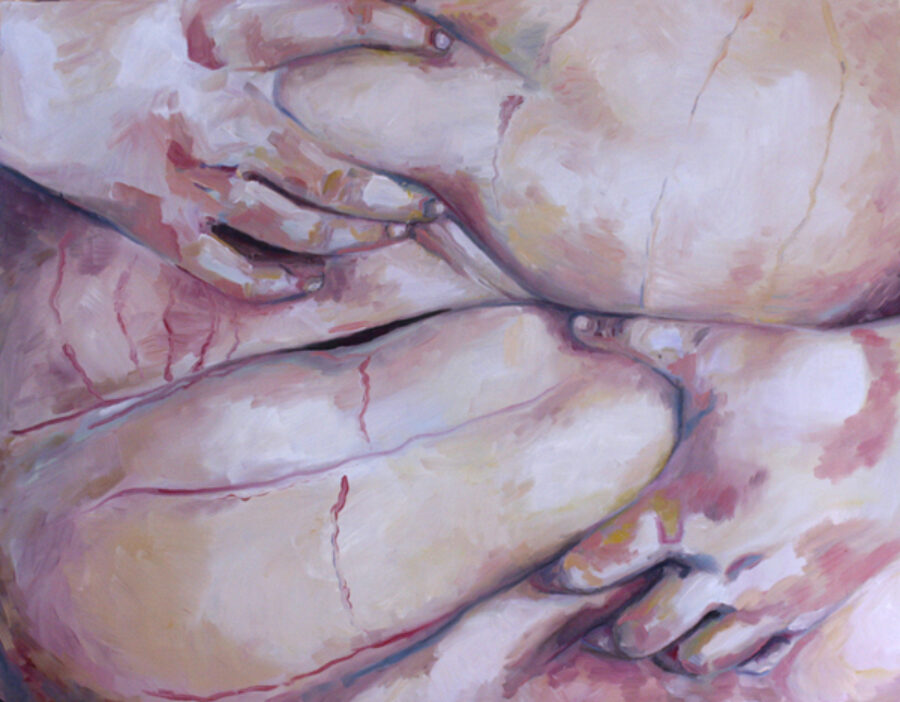
Kara Passey, Self Portrait, 2014
Purposefully Nude
by Kara Passey
I haven’t painted much lately. When I do, it’s mostly large-scale nudes of unconventionally attractive bodies. I focus on their curves and folds, finding beauty in what we have been socialized to believe are imperfections. When I started painting these pictures it was in an attempt to find value in myself: as a fat person fighting with gender and body dysmorphia, painting large-scale imaginings of my naked body was, for lack of a better word, huge.
Using my body as a subject forced me to put myself in positions that were new and scary. I had to learn to get naked in front of a camera and the person controlling it. I had to learn to look at the photos without getting overwhelmed with shame and instantly deleting them off the memory card. Painting my body taught me to accept it and even find beauty within it.
Overcoming the fear of seeing my naked body on canvas has allowed me to become more aware of the way images of the body can be misinterpreted. When I first started painting nudes, there were intense sexual undertones. This was purposefully provocative on my part, but didn’t end up delivering the context that I hoped. I became conscious of how viewers received my naked, sexualized body almost like an invitation to fetishize me. Additionally, they made reductive assumptions about my gender and sexuality. I had been trying to illustrate that my identity is complex and not determined by my body. Instead, I had reduced myself to my physical form and the sex I was having.
When I first started making these paintings, I believed that I was being subversive of the dreaded “male gaze.” But being subversive is unsuccessful if all you are doing is replicating the acts and images that are oppressive. Am I really taking ownership of my body by laying it out provocatively, allowing the viewer to apply whatever sexual context they desire? Is my self-accepting attempt at portraying an unconventional body inclusive if I am only painting one specific experience of my one specific body? Images of female genitalia carry sexual, heteronormative connotations. Such imagery can actively exclude the experiences of trans and/or genderqueer women in the same way that canvas upon canvas depicting white flesh (the history of the nude in Western art!) excludes the experiences of people of colour.
I stepped back and reset my coordinates. My goal became to normalize the naked form in all of its diversity. I started painting bodies other than my own and was careful of how I captured them. I wanted them to be casual, present, simply existing. I wanted to paint bodies in a way that tells their own stories about their identities and experiences, in spite of the preconceptions people may have about their size, ability or presumed sexuality.
I started a new series and put out a call for models. Many people had told me that my paintings had inspired their own body love, and I wanted to provide a platform for physical self-expression and representation to the people who were posing for me. Quickly, however, I realized that certain bodies were volunteering at a faster pace than others. If I wasn’t careful, this series could quickly resemble a Dove advertisement: body acceptance for white, thin, cis-women. Many people aren’t given the space to freely exist simply as they are. They (and for most of my life I counted myself among them) are unlikely to volunteer themselves to become the subject of conversation on a canvas.
As artists, it is our responsibility to be aware of the context in which our work will be received. If I choose to depict models who are conventionally attractive according to the narrow dictates of consumer culture, my work isn’t innovative or inclusive and serves no purpose but to contribute to the societal narrative that I feel alienated by. White, thin, cis-woman bodies should not be the default standard, especially in feminist art. Yet we too often default to what we know, what we have seen, what we believe “the nude” should be.
The nude is highly charged territory. A triangular relationship exists between the artist, the model and the viewer. To disregard the biases and prejudices we bring to this relationship is nothing short of lazy.
Kara Passey is a University of Manitoba Fine Arts grad, current student of Inner City and Urban Studies at the University of Winnipeg, past Arts and Culture Editor of the Manitoban, current community activist and researcher in the North End.
